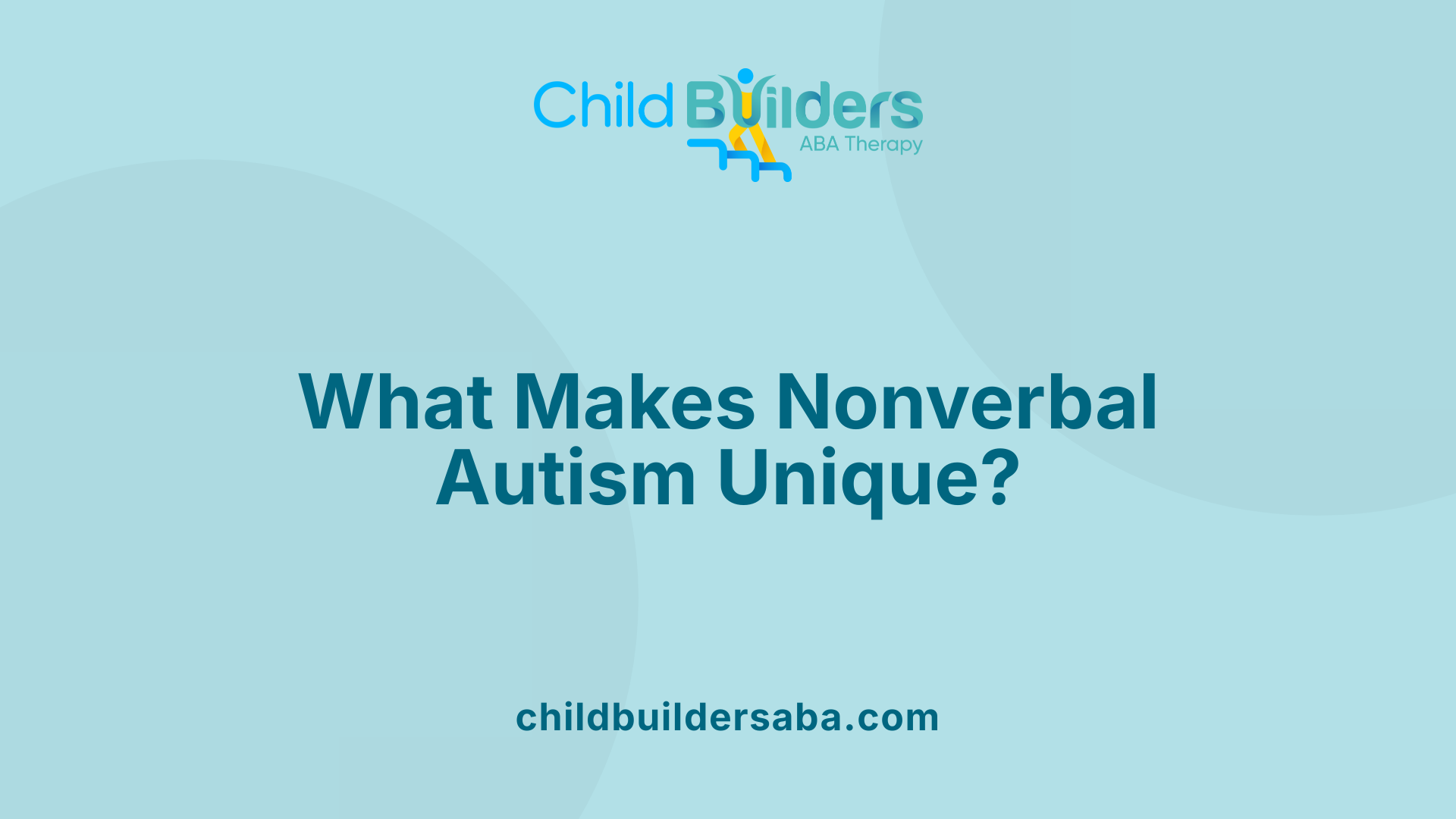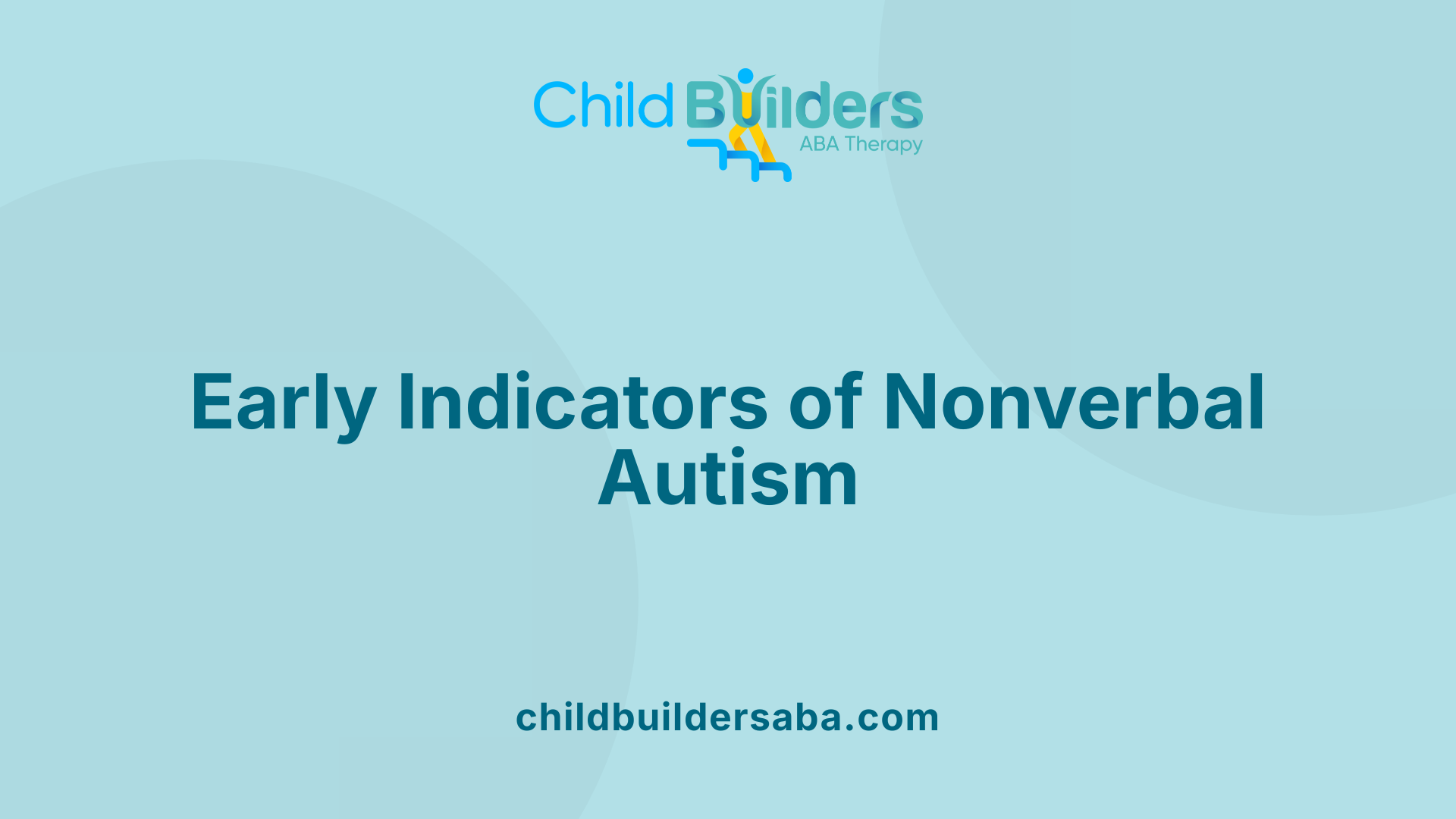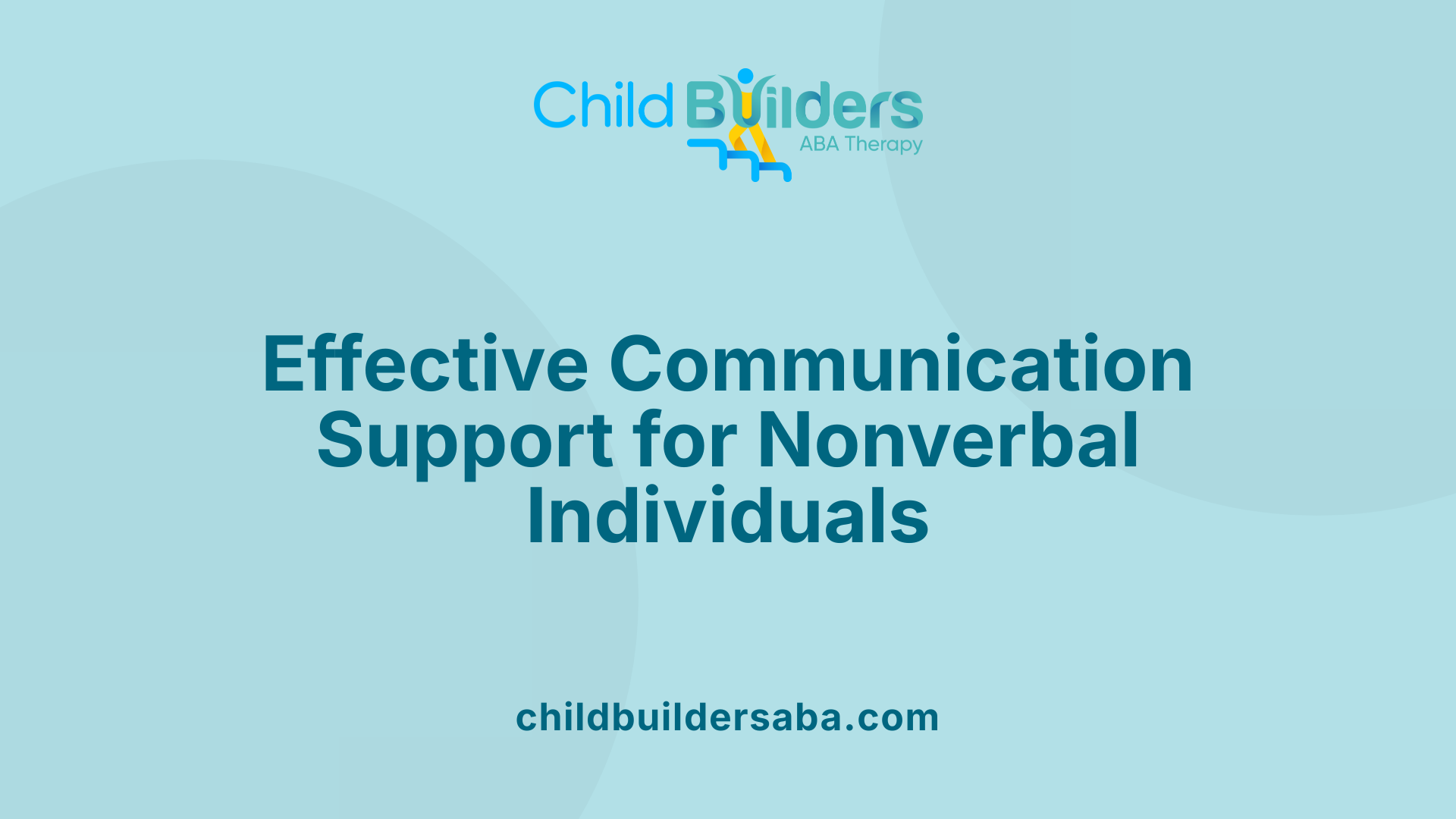Nonverbal Autism

Exploring Nonverbal Autism: Beyond Speech
Nonverbal autism, often referred to as nonspeaking autism, represents a subset of individuals on the autism spectrum who exhibit significant challenges in spoken language development. This comprehensive overview delves into the core characteristics, causes, symptoms, and potential avenues for communication and development, emphasizing the importance of recognition, intervention, and respect for diverse abilities.
Defining Nonverbal Autism and Its Core Traits

What is nonverbal autism and what are its core characteristics?
Nonverbal autism is a term used to describe a subset of individuals with autism spectrum disorder (ASD) who do not develop spoken language or have very limited verbal communication, often not exceeding a few words or sounds. This condition stems from primary neurological differences that hinder the normal development of speech and language skills.
Despite the lack of spoken language, having nonverbal autism does not mean the individual lacks understanding or intelligence. Many people in this group can understand words and may communicate through alternative methods such as gestures, sign language, picture-based systems, or speech-generating devices.
Core features of nonverbal autism include significant difficulty in verbal communication, such as not initiating or responding to conversation, and using sounds instead of words. These individuals often face challenges in social interaction, often avoiding eye contact and having trouble understanding social cues.
In addition, they may display repetitive behaviors, sensory sensitivities, and a preference for routines. Early intervention with strategies like applied behavioral analysis (ABA) and tools like augmentative communication devices can promote language development and improve social skills.
It's important to note that the term 'nonverbal' is increasingly viewed as inadequate or potentially misleading. Many advocates prefer terms that highlight communication abilities beyond speech to better reflect the diverse ways individuals with autism can connect and share information.
By understanding these traits, caregivers and professionals can better support nonverbal individuals through tailored interventions that foster communication and social participation.
Understanding the Causes and Brain Factors
What causes nonverbal autism?
The origins of nonverbal autism are complex and not entirely clear, involving an interplay of genetic, environmental, and neurological factors.
Genetic influences play a significant role. Mutations and genetic disorders such as Fragile X syndrome and tuberous sclerosis are linked to increased autism risk. Prenatal factors like maternal age, pregnancy complications, and early birth also contribute to the development of autism, including cases where individuals do not develop spoken language.
Neurological aspects are crucial in understanding nonverbal autism. Variations in brain structures, especially the amygdala, are associated with communication challenges. Studies show that a smaller amygdala or abnormal activity levels can impair social cues such as eye contact or understanding emotions, which are vital for verbal and nonverbal interaction.
Brain wave patterns, particularly gamma and theta oscillations during semantic processing, may also be disrupted in nonverbal individuals. These neural oscillations are involved in language comprehension and social processing.
Environmental stimuli and sensory processing differences impact nonverbal skills too. Overstimulation, stress, anxiety, or physical discomfort can lead to episodes of shutdowns or decreased responsiveness, often mistaken as a lack of ability.
Overall, while genetic factors lay the groundwork, neurological differences and environmental influences greatly affect why some individuals with autism spectrum disorder remain nonverbal. Understanding these factors can help tailor interventions and support tailored to each individual's unique brain development and needs.
More Information
For further insights, research can be directed towards exploring the causes of nonverbal autism and brain development in nonverbal individuals, which provides a broader understanding of their neurological basis.
Recognizing Symptoms and Early Signs

What are the symptoms of nonverbal autism?
The symptoms of nonverbal autism often include a pronounced difficulty in using spoken language, with many individuals not speaking at all or only producing sounds that lack symbolic meaning. They tend to struggle with social skills such as reading social cues, making eye contact, and understanding gestures or facial expressions. These individuals typically do not respond to their names and may avoid typical social interactions.
Despite their limited verbal communication, many can learn and use alternative methods to express themselves. They might use gestures, pictures, sign language, or devices that generate speech. Repetitive behaviors, sensitivities to sensory stimuli, and challenges in understanding social cues are also prevalent.
Common early signs of nonverbal autism include delayed speech and language development, such as not babbling or laughing by 12 months old. Children may not point to show interest, respond to their name, or engage in typical play involving gestures. Even if they understand what is said to them, they often do not use spoken words to communicate their needs or thoughts.
What are the early signs that can help identify nonverbal autism?
Early signs can appear as a delay in reaching developmental milestones for language. For instance, some children might not start babbling, use gestures, or respond to their name by their first year. They may avoid eye contact and display limited social engagement.
Other indicators include using only a few words if any, not speaking in complete sentences, and not relying on spoken language as the primary way to communicate. Sensory challenges, stereotypic movements, strict routines, and narrow interests may also be apparent.
Detecting these signs early allows families to pursue assessments and interventions, which can significantly improve developmental outcomes. Comprehensive evaluations often involve physical exams, behavioral assessments like ADOS-2, and observation of communication behaviors. Early detection and intervention can help children develop alternative communication skills and improve social interactions.
Progress and Possibility of Speech Development
Can nonverbal autism ever lead to speech development?
It is possible for children with nonverbal autism to develop speech over time. While these individuals do not speak initially, many can learn to communicate verbally through targeted interventions and support.
Research shows that with early and consistent therapy, some nonverbal children start using simple words or even move toward fluent speech later in life. This development is more likely when interventions emphasize language learning and social interaction.
Therapeutic strategies such as speech therapy, modeling clear language, and encouraging social behaviors like gestures and eye contact play a significant role. Using visual supports and assistive devices, including speech-generating technology, can also help foster speech growth.
Some children learn to read and write well before developing spoken language, which can serve as a foundation for speech development later.
It’s important to remember that progress varies greatly among individuals, and not all children will develop speech. However, with supportive interventions, many can improve their communication abilities and experience meaningful language growth.
Supporting language growth
Supporting language development in nonverbal autistic children includes a comprehensive approach involving therapists, families, and educators. Key strategies involve:
- Encouraging play and social interactions
- Imitating the child's behaviors to promote learning
- Waiting patiently for the child to talk or respond
- Simplifying language use to aid understanding
- Focusing on the child’s interests to motivate communication
- Using visual aids, sign language, or alternative communication tools
Consistent, patient support helps create an environment where children can explore and expand their communication skills.
Overall, while some children may never speak in traditional ways, many can develop meaningful, functional communication skills through these tailored efforts. Advances in research and technology continue to improve outcomes and offer hope for many nonverbal individuals.
Communication Strategies and Support Systems

What are effective communication methods for supporting nonverbal individuals with autism?
Supporting nonverbal children with autism involves a variety of approaches that help them express themselves and understand others. Augmentative and alternative communication (AAC) methods are especially valuable. These include sign language, gestures, picture exchange systems like PECS, and advanced electronic devices such as speech-generating apps or communication boards. These tools can bridge language gaps and make communication more accessible.
Visual supports play a crucial role in enhancing understanding. Items like picture schedules, symbols, communication books, and visual cues help individuals grasp routines and share their needs effectively. By reducing reliance on spoken words, visual tools empower users to communicate confidently.
Engaging in consistent social interactions is also vital. Activities that encourage imitation, play, and social engagement help children develop nonverbal communication skills over time. Therapists and caregivers support this process by modeling behaviors, reinforcing gestures or eye contact, and creating opportunities for the individual to communicate at their own pace.
Customizing communication supports to fit each person’s preferences, strengths, and goals is essential. Professionals working with autistic individuals emphasize patience and understanding, recognizing that progress may be gradual. Overall, these strategies foster trust, support language development, and help build meaningful connections.
Therapeutic and Educational Approaches
There is a range of methods designed to support children with autism who are nonverbal or minimally verbal. These approaches aim to improve communication skills, promote social interactions, and foster overall development.
One of the most well-known therapies is Applied Behavior Analysis (ABA). This evidence-based technique involves breaking down skills into small, manageable steps and using positive reinforcement to encourage progress. ABA can include discrete trial training, vocal imitation, and teaching alternative communication methods like sign language or picture exchange systems. Research shows that early and intensive ABA therapy can lead to significant improvements, with some children developing functional speech over time.
Speech therapy plays a vital role by focusing on developing expressive language and nonverbal communication. Speech-language pathologists often incorporate augmentative and alternative communication (AAC) tools, including communication devices, spelling systems, and visual supports like picture boards or PECS (Picture Exchange Communication System). These tools help children communicate their needs and desires, reducing frustration and supporting social engagement.
Sensory and motor therapies are also crucial. Occupational therapy helps children process sensory information more effectively, addressing issues such as sensory overload or aversion. Physical therapy can improve motor coordination and support gross and fine motor skills essential for speech and gesture use. These therapies enable better participation in social and daily activities.
Emerging technologies and interventions complement traditional therapies. Assistive technologies like speech-generating devices provide another avenue for expression. Early diagnosis combined with targeted interventions can lead to substantial gains, even for children who initially show little to no verbal skills.
In summary, a multidisciplinary approach—including ABA, speech therapy, sensory, and motor therapies—offers the best chance for children to develop communication abilities, learn social skills, and lead fulfilling lives.
Intelligence, Abilities, and Misconceptions
Are individuals with nonverbal autism less intelligent, or do they have different abilities?
Many people mistakenly assume that being nonverbal equates to a lack of intelligence. However, this is not accurate. Nonverbal autism does not mean that a person has lower or no intelligence. In fact, many individuals with nonverbal autism are highly capable in certain areas, including visual reasoning, memory, and problem-solving.
Traditional IQ tests that depend on verbal communication often underestimate their cognitive skills. These assessments typically require speaking, reading, or explaining answers, which can be challenging for nonverbal individuals. To better understand their abilities, professionals often use alternative tools such as the Leiter International Performance Scale or Raven’s Progressive Matrices. These tests do not rely on language and can provide a more accurate measure of intelligence.
Research shows that early cognitive abilities tend to remain stable over time, especially when assessed with suitable methods. While some nonverbal individuals may not speak, they can still understand language and learn complex concepts. They may communicate through gestures, writing, or using assistive technologies like speech-generating devices.
It’s important to recognize that abilities vary widely among individuals with nonverbal autism. Verbal skills are just one aspect of intelligence. Many excel in other areas, demonstrating creativity, memory, and logical thinking. Therefore, the absence of speech should not be viewed as a definitive indicator of a person's overall intelligence or potential.
| Aspect | Explanation | Additional Notes |
|---|---|---|
| verbal IQ | Often underestimates ability | Limited for nonverbal individuals |
| nonverbal IQ tests | Accurate assessment tools | Leiter, Raven’s matrices |
| abilities | Diverse and varied | Visual reasoning, problem-solving |
| misconceptions | Verbal ability = intelligence | Needs reevaluation |
Understanding cognitive abilities in nonverbal autism requires careful assessment and an open mind. Recognizing that intelligence manifests in many forms helps promote respect, appropriate support, and opportunities for growth.
Lifespan and Long-term Outlook
The lifespan outlook for individuals with nonverbal autism varies widely and is influenced by several factors, including access to healthcare, ongoing support, and the presence of additional health conditions. Generally, research indicates that autistic individuals tend to have a shorter life expectancy compared to the general population.
on average, life expectancy for autistic individuals ranges from approximately 39 to 58 years. Those with severe autism or co-occurring health issues, such as epilepsy, gastrointestinal problems, or respiratory conditions, may have an even lower projected lifespan, sometimes around 35 to 40 years.
Multiple health risks contribute to this reduced expectancy. These include increased vulnerability to seizures, accidents, and infections, as well as complications related to sleep disturbances and mental health challenges like anxiety or depression. Early diagnosis, regular medical care, and comprehensive support can positively influence both quality of life and longevity.
Access to specialized healthcare and ongoing therapies can help manage health risks, improve daily functioning, and foster independence. Social support networks and community services are also vital in enhancing well-being.
While many individuals with nonverbal autism live into adulthood and lead fulfilling lives, their overall lifespan can be influenced by the quality of medical and social interventions they receive. Continuous efforts to address health concerns and promote inclusive living environments are essential to help extend lifespan and improve health outcomes.
Supporting Diversity in Communication and Ability
Recognizing nonverbal autism as a diverse and complex condition is essential for fostering understanding, providing appropriate interventions, and respecting individual capacities. Through early intervention, innovative therapies, and personalized communication strategies, many individuals with nonverbal autism lead meaningful, connected lives. As research advances, our collective goal remains to enhance quality of life, promote development, and challenge misconceptions about intelligence and potential, emphasizing that communication extends far beyond spoken words.
References
- “Nonverbal” Autism: What It Means | Northwestern Medicine
- Nonverbal autism - Wikipedia
- Teaching nonverbal autistic children to talk - Autism Speaks
- What is Nonverbal Autism? Dispelling the Myths - LEARN Behavioral
- Nonverbal autism: Symptoms, diagnosis, and treatment
- Definitions of Nonverbal and Minimally Verbal in Research for Autism
- What I Wish People Understood About Non-Speaking Autistics Who ...
- Signs of Nonverbal Autism in Children - Golden Care Therapy





.jpg)































































































